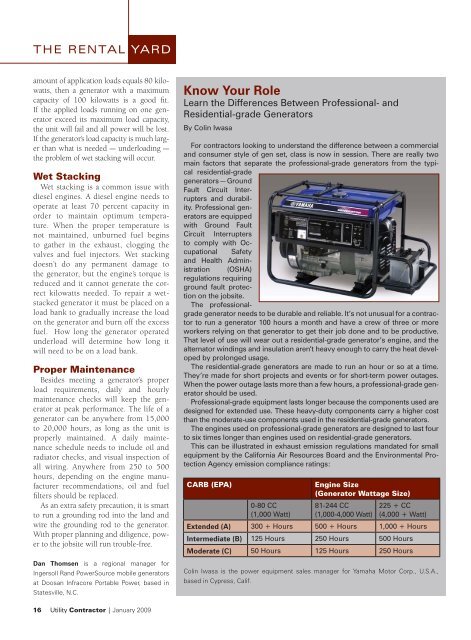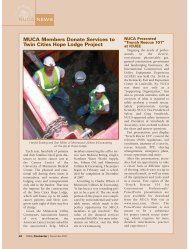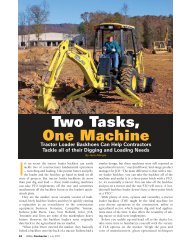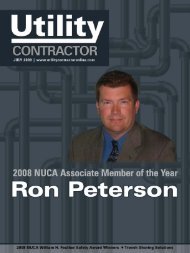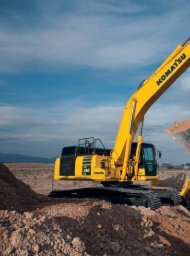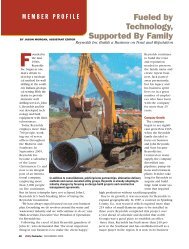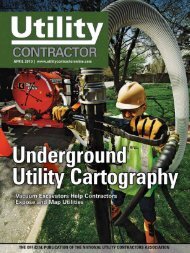View Full January PDF Issue - Utility Contractor Online
View Full January PDF Issue - Utility Contractor Online
View Full January PDF Issue - Utility Contractor Online
You also want an ePaper? Increase the reach of your titles
YUMPU automatically turns print PDFs into web optimized ePapers that Google loves.
THE RENTAL YARDamount of application loads equals 80 kilowatts,then a generator with a maximumcapacity of 100 kilowatts is a good fit.If the applied loads running on one generatorexceed its maximum load capacity,the unit will fail and all power will be lost.If the generator’s load capacity is much largerthan what is needed — underloading —the problem of wet stacking will occur.Wet StackingWet stacking is a common issue withdiesel engines. A diesel engine needs tooperate at least 70 percent capacity inorder to maintain optimum temperature.When the proper temperature isnot maintained, unburned fuel beginsto gather in the exhaust, clogging thevalves and fuel injectors. Wet stackingdoesn’t do any permanent damage tothe generator, but the engine’s torque isreduced and it cannot generate the correctkilowatts needed. To repair a wetstackedgenerator it must be placed on aload bank to gradually increase the loadon the generator and burn off the excessfuel. How long the generator operatedunderload will determine how long itwill need to be on a load bank.Proper MaintenanceBesides meeting a generator’s properload requirements, daily and hourlymaintenance checks will keep the generatorat peak performance. The life of agenerator can be anywhere from 15,000to 20,000 hours, as long as the unit isproperly maintained. A daily maintenanceschedule needs to include oil andradiator checks, and visual inspection ofall wiring. Anywhere from 250 to 500hours, depending on the engine manufacturerrecommendations, oil and fuelfilters should be replaced.As an extra safety precaution, it is smartto run a grounding rod into the land andwire the grounding rod to the generator.With proper planning and diligence, powerto the jobsite will run trouble-free.Dan Thomsen is a regional manager forIngersoll Rand PowerSource mobile generatorsat Doosan Infracore Portable Power, based inStatesville, N.C.Know Your RoleLearn the Differences Between Professional- andResidential-grade GeneratorsBy Colin IwasaFor contractors looking to understand the difference between a commercialand consumer style of gen set, class is now in session. There are really twomain factors that separate the professional-grade generators from the typicalresidential-gradegenerators — GroundFault Circuit Interruptersand durability.Professional generatorsare equippedwith Ground FaultCircuit Interruptersto comply with OccupationalSafetyand Health Administration(OSHA)regulations requiringground fault protectionon the jobsite.The professionalgradegenerator needs to be durable and reliable. It’s not unusual for a contractorto run a generator 100 hours a month and have a crew of three or moreworkers relying on that generator to get their job done and to be productive.That level of use will wear out a residential-grade generator’s engine, and thealternator windings and insulation aren’t heavy enough to carry the heat developedby prolonged usage.The residential-grade generators are made to run an hour or so at a time.They’re made for short projects and events or for short-term power outages.When the power outage lasts more than a few hours, a professional-grade generatorshould be used.Professional-grade equipment lasts longer because the components used aredesigned for extended use. These heavy-duty components carry a higher costthan the moderate-use components used in the residential-grade generators.The engines used on professional-grade generators are designed to last fourto six times longer than engines used on residential-grade generators.This can be illustrated in exhaust emission regulations mandated for smallequipment by the California Air Resources Board and the Environmental ProtectionAgency emission compliance ratings:CARB (EPA)0-80 CC(1,000 Watt)Engine Size(Generator Wattage Size)81-244 CC(1,000-4,000 Watt)225 + CC(4,000 + Watt)Extended (A) 300 + Hours 500 + Hours 1,000 + HoursIntermediate (B) 125 Hours 250 Hours 500 HoursModerate (C) 50 Hours 125 Hours 250 HoursColin Iwasa is the power equipment sales manager for Yamaha Motor Corp., U.S.A.,based in Cypress, Calif.16 <strong>Utility</strong> <strong>Contractor</strong> | <strong>January</strong> 2009


